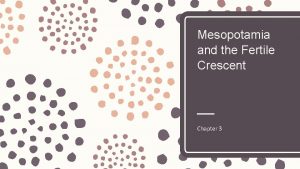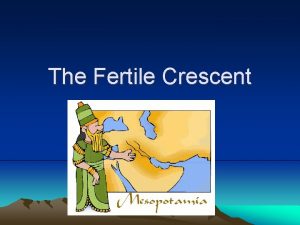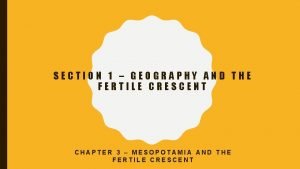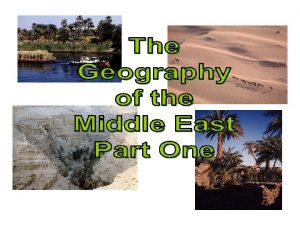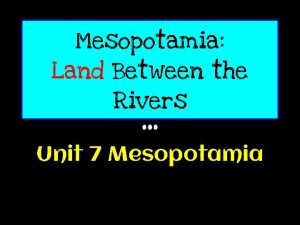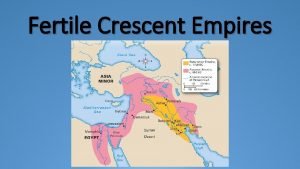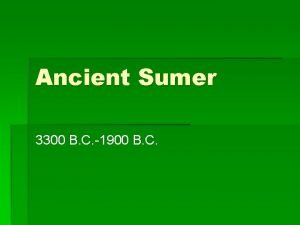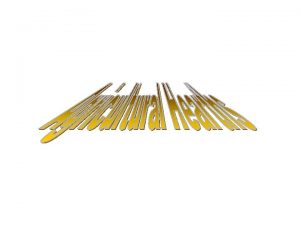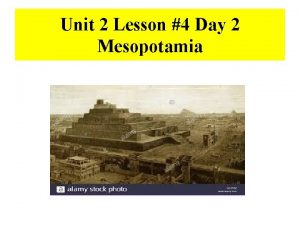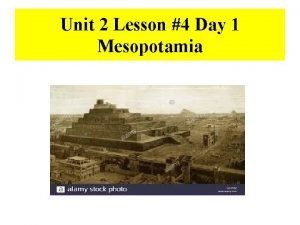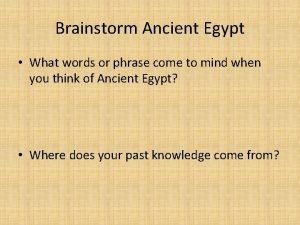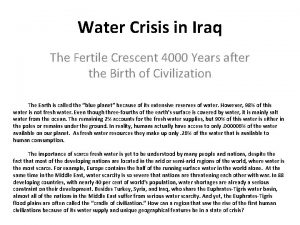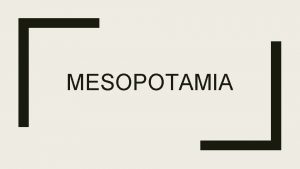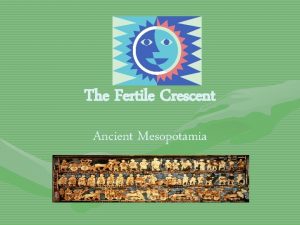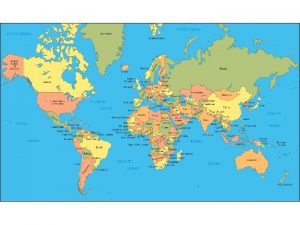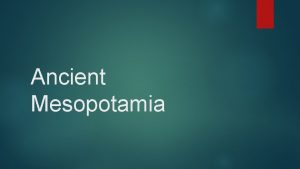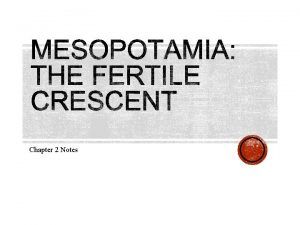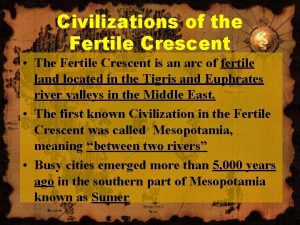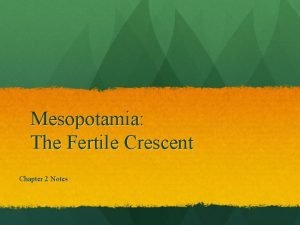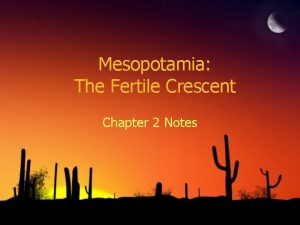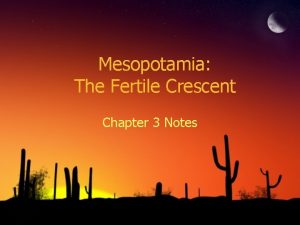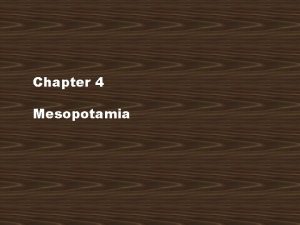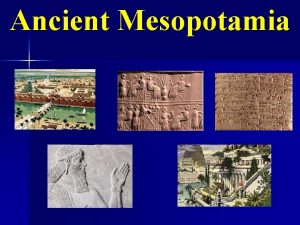Mesopotamia and the Fertile Crescent Chapter 3 Geography

















- Slides: 17

Mesopotamia and the Fertile Crescent Chapter 3

Geography in the Fertile Crescent – The Tigris and Euphrates rivers are the most important physical features of the region known as Mesopotamia. – Farm settlements in Mesopotamia eventually developed into civilizations.

Geography in the Fertile Crescent – Mesopotamia means “between the rivers” in Greek. – Mesopotamia is part of a larger area of rich farmland called the Fertile Crescent. – Mesopotamia was divided into two regions in ancient times: northern and southern Mesopotamia.

Geography in the Fertile Crescent – Annual floods on the Tigris and Euphrates rivers brought silt that made the land ideal for farming. – Silt is a mixture of rich soil and tiny rocks. Plentiful food led to population growth and the formation of villages. – Villages later developed into the world’s first civilizations. – Farmers used irrigation and canals as a way to control river flow. – Increased amounts of food led to surpluses, which meant that fewer people needed to farm. – As a result, new occupations developed.

Geography in the Fertile Crescent – Irrigation increased the amount of food farmers produced. – This created a food surplus, or more food than they needed. – Fewer people needed to farm, so they took on other roles and jobs. – When workers specialize in a particular task, a division of labor is created. – Large projects were undertaken, which led to the need for structure and rules. – Settlements grew in size, creating cities between 4000 and 3000 B. C.

The Rise of Sumer • City-States – Consisted of a city and all of the surrounding countryside – The amount of countryside in each city-state depended on its military strength. – Fought each other to gain more farmland – Gained and lost power over time

The Rise of Sumer – Sumerian polytheism was the basis for all Sumerian society. – Polytheism is the worship of many gods. – Gods had enormous powers. – Priests had great statues built in Sumer. – Priests were people who performed religious ceremonies.

The Rise of Sumer Social hierarchy: the division of society by rank or class – Kings were at the top of the order because they claimed to be chosen to rule by the gods. – Social order – Kings – Priests – Skilled craftspeople, merchants, and traders – Large working class of farmers and laborers – Slaves

The Rise of Sumer – Men and Women in Sumer – Men generally held the political power and made laws. – Women generally took care of the home and children. – Education was generally reserved for men, but some upper class women were educated. – Some women were priestesses in Sumerian temples. – Enheduanna, a priestess who wrote hymns, is the first known female writer in history.

Sumerian Achievements – Sumerian invented the world’s first writing system – The cuneiform system involved the use of sharp tools called styluses. – The Sumerians first used cuneiform to keep business records. – The Sumerians also used their writing skills to write books about history, poems, and math.

Inventions in Writing – Cuneiform • World’s first system of writing • Cuneiform symbols could represent syllables. Earlier pictographs had represented only objects. • The Sumerians wrote on clay tablets with a stylus.

Inventions in Writing – Scribes • Writers • Kept track of items people traded and wrote down government records • Scribes could move up in social class.

Inventions in Writing – Other Uses • Wrote works of literature, stories, proverbs, and songs • Wrote poems about the gods and military victories. • Created epics, long poems that tell the stories of heroes.

Architecture • Rulers lived in large palaces. • Most Sumerians lived in houses with many rooms around a small courtyard. • Mud bricks were the houses’ main building blocks. • A ziggurat, or pyramid-shaped temple tower, rose above each city.

The Arts • Sculptors produced many statues of the gods for their temples. • Jewelry was a popular item made from imported gold, silver, and gems. • Engraved cylinder seals are one of Sumer’s most famous types of art. • Battle scenes • Show ownership • Highly decorative

Hammurabi – Babylon’s king and the city’s greatest monarch, or ruler of a kingdom or empire – Brilliant war leader who brought all of Mesopotamia into his Babylonian Empire – Oversaw building and irrigation projects and improved the tax system – Developed a set of laws that was written down for all to see

Hammurabi’s Code – Hammurabi wrote down 282 laws which contained some ideas still found in laws today. – Specific crimes brought specific penalties. – Social class was taken into account. It was a greater crime to injure a rich man than a poor one. – It was unique not only because of how thorough it was, but also because he wrote it down for all to see.
 Geography of the fertile crescent
Geography of the fertile crescent Geography of the fertile crescent
Geography of the fertile crescent Fertile crescent ap human geography definition
Fertile crescent ap human geography definition Geography of the fertile crescent
Geography of the fertile crescent Geography of the fertile crescent
Geography of the fertile crescent Fertile crescent
Fertile crescent Fertile crescent location
Fertile crescent location Perfect location
Perfect location Fertile crescent
Fertile crescent 3300 bc
3300 bc Fertile crescent hearth
Fertile crescent hearth Unit 2 lesson 4 fertile crescent
Unit 2 lesson 4 fertile crescent Unit 2 lesson 4 fertile crescent
Unit 2 lesson 4 fertile crescent The fertile crescent is the arc of land that
The fertile crescent is the arc of land that Fertile crescent
Fertile crescent Fertile crescent
Fertile crescent Fertile crescent
Fertile crescent Where's the fertile crescent
Where's the fertile crescent
